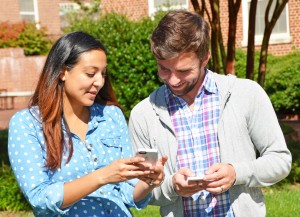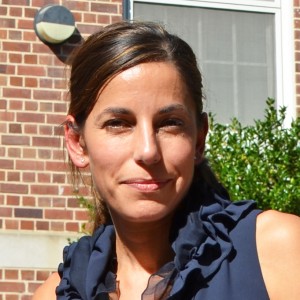Slowing the spread of flu
December 7, 2015
We know the symptoms…
…sudden onset of chills, fever, sore throat, runny nose, body aches. It’s the misery commonly known as the flu, a virus that kills thousands of people and costs tens of billions of dollars each year in the U.S. alone.
Flu strains contracted during fall and winter pandemic preparedness measures among groups of are spread primarily through proximal airborne contact – i.e., anyone within six feet of someone who has the flu can become infected with the virus. Because so many are at risk, Allison Aiello, PhD, thought an app to track interactions and monitor transmission of flu might be a useful research tool.
Aiello is professor of epidemiology at UNC’s Gillings School of Global Public Health.
“Virtually everyone has a cellphone these days, and so many apps can determine your location and the location of people with identical apps,” Aiello says. “Why not use this technology to track interactions and better understand how people get sick? We can use data based on people’s interactions with friends and acquaintances to determine how to prevent transmission in their social networks.”

Erline Miller and John Easterbrook compare notes about Dr. Aiello’s study. (Photo by Linda Kastleman)
The idea is a natural extension of Aiello’s general research interests. She has spent much of her career tracking linkages to infection in community settings and examining how to prevent or track outbreaks and disease blooms. She has studied the use of antibacterial soaps – “Avoid them,” she says – and has investigated students, whom she calls “an understudied and at- risk population.” She has explored the relationship of socio-economic status to infectious diseases that have been linked to chronic disease and has noted a “disproportionate negative impact among the poor.” Finding a new way to track and prevent the spread of flu is in keeping with her interests and skills, especially since most students she knows own smartphones.
“Smartphones’ GPS, Bluetooth and wireless capabilities made them an ideal tool for our initial study, which was located in university residence halls,” she says. “We needed software to help us track participants in our study when they came close enough to each other to become infected with a respiratory virus – that and a good sampling of study subjects who were likely to come into close physical proximity to each other.”
Smartphone ownership and physical proximity? That’s practically a definition of “college students.” Aiello and colleagues knew they didn’t have skills to code their own app, but they found one they could adapt with some modifications. They reached out to the creators of iEpi and soon had the modifications they needed to conduct an initial study.
“We worked with the iEpi team to optimize the app for what we had in mind,” Aiello says. “Then, we put it to work.”
Her team enlisted 100 college students on a single campus to participate in the study. For 10 weeks during the 2013 flu season, the students were given Google Android smartphones preloaded with iEpi. The app kept a record of people with whom the students came in contact over that period, and the students self-recorded any symptoms of illness.
Students also were asked to note their hand-washing habits, whether or not they had received a flu shot, and whether and when they used tobacco or alcohol. Those who reported any flu symptoms (e.g., coughing, fever, chills, body aches) received nose and throat swab tests to determine whether they had been infected with influenza or other respiratory viruses that cause cold- or flu-like symptoms.
Aiello and her collaborators created a model based on the data and tracked contact and spread of the flu over the 10 weeks. The more data the model received, the better it became at affirming that the virus was spreading through proximal or physical contact. It predicted where outbreaks would occur and which people students should avoid to prevent becoming infected. It also showed that students who smoked or regularly consumed alcohol recovered more slowly from influenza- like illnesses.
“The results were very encouraging,” Aiello says. “The study showed that it is possible to harness the power of collecting real-time data with smart phone apps to measure interactions and behaviors more accurately. Our sample of 100 students was the largest study to date using this type of app to track interactions and influenza, and our results show it is possible to scale up beyond 100 individuals in future work. Collecting these types of data in large- scale populations will help us better understand transmission and risks for many diseases that are driven by social interactions.”
Aiello finds it exciting to collect health information through smartphones and wearable technology. “It is clear that the development of apps that will allow us to better track illnesses in various settings will inform our ability to prevent and treat illness,” she says.

Aiello is working with collaborators to develop and apply wearable sensors that will collect data continuously, including when people cough or sneeze. Obtaining more uninterrupted data over longer periods can help track and potentially prevent epidemics. (Photo by Linda Kastleman)
Aiello believes these opportunities serve as a window into the future
of epidemiological data collection. “This technology has allowed us to better assess the context in which social and behavior practices influence health,” she says. “It’s easy to see how such modeling could track and even restrict infection of certain types of diseases in corporations, child- care centers, hospitals or even large-scale social settings. The more data collected in real time, the more refined and accurate the apps will become in helping to predict and identify disease hotspots. As these technologies take off, we will need to stay ahead of the curve by addressing issues related to big data collection and the ethical implications of securing individuals’ data and privacy.”
Aiello and her team presented the research in August 2015 at the 21st International Conference on Knowledge Discovery and Data Mining in Sydney, Australia.
As for what’s next, Aiello foresees refinement and expansion of the app’s capabilities and adaptability.
“We want to take these ideas to the next level,” she says. “We are working with engineers to collect more finely measured interaction data through small, wearable sensors. Someday, this will allow us to recognize when a participant coughs or sneezes, and we’ll be able to send these data to smartphones for continuous data collection.”
– David Pesci
Header photo by Linda Kastleman
Carolina Public Health is a publication of the University of North Carolina at Chapel Hill Gillings School of Global Public Health. To view previous issues, please visit sph.unc.edu/cph.
